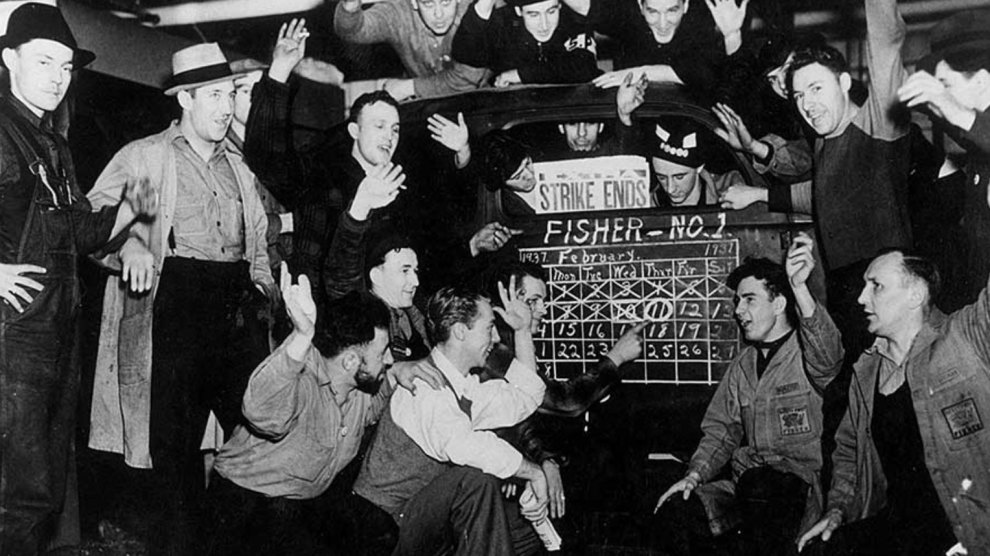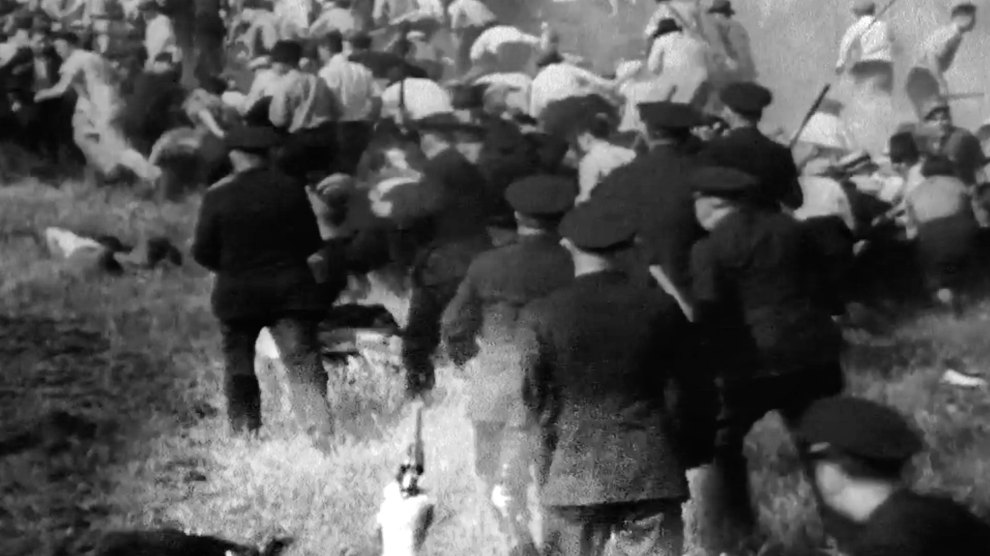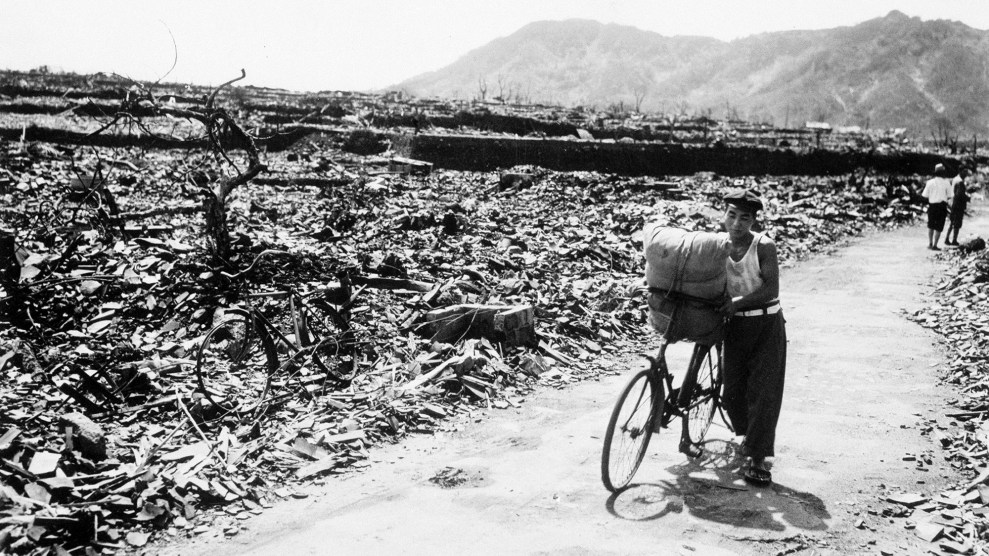
A scene from the sit-down strike at GM's Fisher Body No. 1 plant in Flint, Michigan, which began on December 30, 1936, and lasted 44 days.UAW
On Tuesday, leaders of the striking United Auto Workers vowed to expand their labor action against the Big Three automakers Friday if contract talks break down. Now in its second week, the strike has drawn widespread attention, but it’s only the latest indication of the broader resurgence of union organizing by the likes of Starbucks workers, big city teachers’ unions, Marvel digital effects workers, Uber and Lyft drivers, and, of course, Hollywood actors and screenwriters. In August, the threat of a United Parcel Service strike with Teamster support resulted in a new contract, and some of Amazon’s massive warehouses are simmering with labor unrest.
Yet all of today’s labor organizers stand on the shoulders of their forebears who, during the mid-1930s, amid the depths of the Great Depression, established or expanded key unions in the steel and auto industries and founded all of the Hollywood guilds. Central to many of their advances was a fresh tactic: “sit down strikes,” wherein workers would stay put in their factories and workspaces, not to be easily dislodged. This strategy brought about widespread victories, benefiting everyone from Woolworth’s lunch-counter workers to (as we’ll see) assembly line workers at GM and Ford. Unions remained powerful for decades, although a concerted effort by business leaders and their Republican friends in Congress, and moving of jobs overseas, would ultimately erode their membership gains. Today, only about 10 percent of US employees belong to a union.
The following commentary, adapted from my recent oral history book and PBS film, Memorial Day Massacre: Workers Die, Film Buried, takes us back to that earlier era and tells the story of how things went down in the 1930s.
Howard Zinn, historian: The country was in turmoil in the 1930s when [Franklin D.] Roosevelt came into office. There were strikes all over the country. There were riots. There were people breaking into places where there was food. There were children marching into city halls demanding that they be fed and taken care of. It was a country that was in a state of near-revolution, something that very much worried the people in Washington. Certainly Roosevelt was sensitive to this. The New Deal was the result of it—the result of the combination of Roosevelt’s sensitivity and the events, the uproar, the rebellions taking place all over the country, which he had to take notice of.
John Hope Franklin, historian: We were waking up from a long period of lethargy that was a part of the early years of the Depression. And how do you get beyond this? How do you pull out of this? You pull out of it by having programs of one kind or another that will focus on the problems of the day—the economy, voting, civil rights, and political rights.
And so in all these areas you had action. The labor unions were active, and of course they found in the federal government under the leadership of Roosevelt a very good friend, and through him and people like Senator Robert Wagner you got very effective legislation. They found that the political process was being opened up.
Victor Reuther, UAW organizer: It had seemed like everywhere we went across the country workers were on strike and they were moving towards a form of industrial democracy. It was an exhilarating period and it gave one new faith in what we call democracy. Because democracy is not restricted to voting for someone for president once every four years. It is something that you can utilize and participate in where you work eight hours or 10 hours a day. That kind of democracy is especially meaningful, and we were experiencing it.
Studs Terkel, actor, radio host, and author-to-be: There were labor battles, historic ones, where the fight for the eight-hour day had begun. It brought the song: “Eight hours we’d have for working, eight hours we’d have for play, eight hours for sleeping, in free Ameri-kay.”
Reuther: My brother Walter Reuther resolved in 1935 that we would build an industrial trade union in the auto industry. And there were encouraging developments. There was the beginning of the CIO [Congress of Industrial Organizations], in which a few trade union leaders had the courage to break with an outworn union structure of “craftism,” which served only the interest of the elite. It provided a trade union structure that would embrace even the unskilled factory workers in steel, auto, rubber, in textile, in shipbuilding, and to forge them into not only a great economic organization that could offer hope to those who worked in the factories, mines and mills, but to become a powerful force influencing the kind of social legislation that our country desperately needed.
The old AF of L [American Federation of Labor] was content to serve the needs only of the highly skilled, the elite in the workforce—the electricians, the carpenters, the pipe fitters, the plumbers, the metal finishers, et cetera. We learned from the European experience that industrial unionism was needed in vast, new industries, where the skill of a few workers may be important but justice was needed for the great mass of workers who worked on assembly lines. For example, on the west side of Detroit several hundred thousand autoworkers were employed, but only a handful unionized. And unless their income could be increased to the point that they could become consumers of the products they produce, there would be no healthy basis for economic growth and prosperity.
We set as our goal building one union for all who worked in the same industry. Even as late as 1936, while the New Deal had clearly identified itself with the needs of the working class, we hadn’t seen much in the industrial areas to be terribly enthusiastic about. What we were really suggesting: It wasn’t enough in America to have political democracy. We needed industrial democracy.
Zinn: The idea of sit-down strikes spread through 1936. In December of that year began the longest sit-down strike of all, at Fisher Body plant #1 in Flint, Michigan. It started when two brothers were fired, and it lasted until February 1937. For forty days there was a community of 2,000 strikers. “It was like war,” one said. “The guys with me became my buddies.”
Sidney Fine in Sit-Down describes what happened: Committees organized recreation, information, classes, a postal service, sanitation. Courts were set up to deal with those who didn’t take their turn washing dishes or who threw rubbish or smoked where it was prohibited or brought in liquor. A restaurant owner across the street prepared three meals a day for two thousand strikers. There were classes in parliamentary procedure, public speaking, history of the labor movement. Graduate students at the University of Michigan gave courses in journalism and creative writing.
There were injunctions, but a procession of 5,000 armed workers encircled the plant and there was no attempt to enforce the injunction. Police attacked with tear gas and the workers fought back with firehoses. Thirteen strikers were wounded by gunfire, but the police were driven back. The governor called out the National Guard. By this time the strike had spread to other General Motors plants. Finally there was a settlement, a six-month contract, leaving many questions unsettled but recognizing that from now on, the company would have to deal not with individuals but with a union.
In 1936 there were 48 sit-down strikes. In 1937 there were 477: electrical workers in St. Louis; shirt workers in Pulaski, Tennessee; broom workers in Pueblo, Colorado; trash collectors in Bridgeport, Connecticut; gravediggers in New Jersey…The sit-downs were especially dangerous to the system because they were not controlled by the regular union leadership.
Reuther: We won an incredible victory at the General Motors Kelsey plant in just 10 days. We won a signed agreement that recognized our union, that set up a system of elected shop stewards to handle our grievances, that provided for seniority. Black workers in the foundry were given the right to do something besides working as chip pullers and sweepers. Women workers, who were getting 22-1/2 cents an hour while I was getting 33, all of us went to 75 cent minimum after that 10-day strike. Do you realize how much of an increase that is? Unbelievable!
We settled Kelsey’s strike on Christmas Eve in 1936. The jubilation of the victorious strikers, but equally the jubilation of the community—their outlook on life had suddenly changed, and it had changed because something they did. All this talk about democracy had been so remote. It was something in Washington or Lansing. Now democracy is something they can grab a hold of and do something about with their own strength.
It was the most exhilarating experience I could possible imagine. The jubilation is comparable to the freeing of a people at the end of a war, literally. It was a liberating force set loose that was infectious and spreading across the country. Steel workers were engaged in strikes and winning, rubber workers in Akron, garment workers in the South who had never really won a victory before. Incredible!
It was infectious, because a form of unionization was suddenly made available to them which disregarded the old prejudices that separated us: the skilled from the unskilled, the blacks from the white, the women from the men. The industrial union structure was the epitome of democracy.
Terkel: Though the breadline was beginning to resemble an endless, silent, gray snake dance, there was a salubrious note in the air. Flutelike. Something around the corner. Not prosperity, no. That had always been around the corner, but never quite made the turn. Something funny had happened. There was a deep Depression, true, but an elfin air pervaded, as insouciant as Roosevelt’s tilted cigarette holder. Hope has never trickled down, it has always sprung up.
Reuther: Just as [CIO and mineworkers union leader] John L. Lewis stood like a Rock of Gibraltar at our side in the great sit-down strikes and wasn’t easily intimidated by the corporate threats, so Franklin Roosevelt stood firm, too. He was, for a short period, tempted to authorize the troops going into Flint, but fortunately he had put some stalwart people on his cabinet. These were people who had a feeling for the deep social problems that existed. They knew that they couldn’t be solved at the point of a bayonet, and that Roosevelt shouldn’t take on that role of using troops to tip the scales on behalf of the corporate structure. In American labor history, troops have been called in often in coal mines, in textile strikes, and the troops have always been used against the strikers to help bail out the corporate interests. John L. Lewis was right when he finally threatened, “I will go and stand beside those sitting down in the plant, and when the bullet strikes my chest and my body falls, you will hear the echo of it.”
FDR stood on our side of not using the troops against us. Steel workers took heart from that, clothing workers did. Whatever personal reservations I may have had about which side FDR was on, they were certainly ended with the tremendous support which we got from him and from his cabinet in the middle of the great General Motors strike. To me, that was life and death for the whole industrial labor movement. When the auto workers took on the most powerful corporation in the world, General Motors, with its private army, with its secret deals with the Pinkerton Agency, with its political power at the highest of levels, it was a real life and death battle. If the president of the United States had done what presidents traditionally had done, called out the National Guard and used them to save the companies, we would have lost.
And the defeat of the whole CIO would have spelled disaster for American democracy. Once the workers had occupied the plants, once the corporate side had signed an agreement with them setting forth specific conditions of work and benefits, et cetera, and a respect for the worker and their rights, there was no turning back to the old way of just the boss giving orders and if you didn’t like it, you’d be fired. There was a new chapter written in American democracy and in industrial relations. And once the workers tasted that freedom, they were resolved never to give it up.
Gore Vidal, author: I would say that FDR did save the country from ’33 to ’36. He was rather flawed, but I think he was a superb president in the first term. He saved capitalism. Whether this is a good thing or not I am not about to betray my sentiments. But he saved it. It could very well have gone under, and those who said, “He’s a traitor to his class” didn’t realize he was their savior.
I see no legacy of Franklin Roosevelt. We have no political system at all. We have a sort of corporate party with two wings, both financed by a national security state. Most of the revenues for decades have gone to what we’ve euphemistically called defense. I have seen nobody at all like the Roosevelt of ’33-’36, the social ameliorist, to bring us together. We may suddenly have on the horizon, if we are lucky, a Franklin Roosevelt. And if we’re not lucky, Oliver Cromwell.
In addition to his more than a dozen books and PBS films, Greg Mitchell is the author of the Substack newsletters Between Rock and a Hard Place and Oppenheimer: From Hiroshima to Hollywood.
















